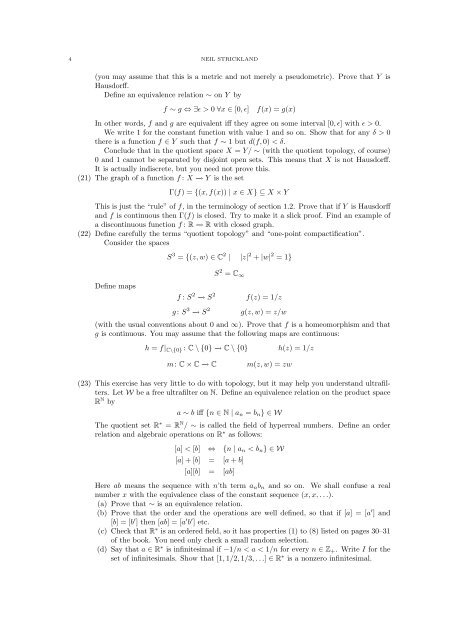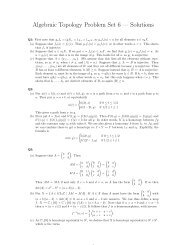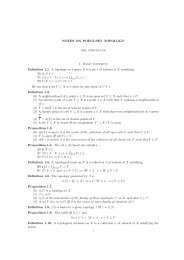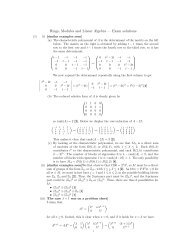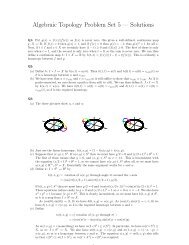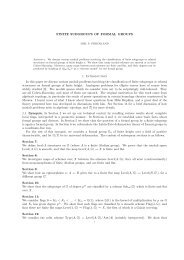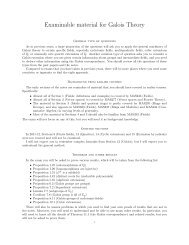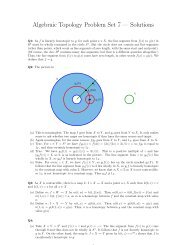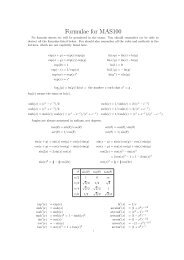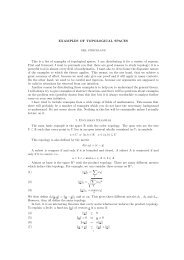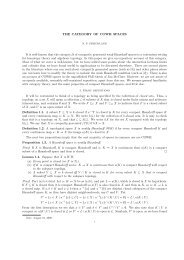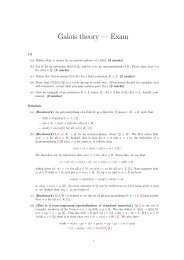TOPOLOGY PROBLEMS (1) State the Arzela-Ascoli ... - Neil Strickland
TOPOLOGY PROBLEMS (1) State the Arzela-Ascoli ... - Neil Strickland
TOPOLOGY PROBLEMS (1) State the Arzela-Ascoli ... - Neil Strickland
Create successful ePaper yourself
Turn your PDF publications into a flip-book with our unique Google optimized e-Paper software.
4 NEIL STRICKLAND<br />
(you may assume that this is a metric and not merely a pseudometric). Prove that Y is<br />
Hausdorff.<br />
Define an equivalence relation ∼ on Y by<br />
f ∼ g ⇔ ∃ɛ > 0 ∀x ∈ [0, ɛ]<br />
f(x) = g(x)<br />
In o<strong>the</strong>r words, f and g are equivalent iff <strong>the</strong>y agree on some interval [0, ɛ] with ɛ > 0.<br />
We write 1 for <strong>the</strong> constant function with value 1 and so on. Show that for any δ > 0<br />
<strong>the</strong>re is a function f ∈ Y such that f ∼ 1 but d(f, 0) < δ.<br />
Conclude that in <strong>the</strong> quotient space X = Y/ ∼ (with <strong>the</strong> quotient topology, of course)<br />
0 and 1 cannot be separated by disjoint open sets. This means that X is not Hausdorff.<br />
It is actually indiscrete, but you need not prove this.<br />
(21) The graph of a function f : X −→ Y is <strong>the</strong> set<br />
Γ(f) = {(x, f(x)) | x ∈ X} ⊆ X × Y<br />
This is just <strong>the</strong> “rule” of f, in <strong>the</strong> terminology of section 1.2. Prove that if Y is Hausdorff<br />
and f is continuous <strong>the</strong>n Γ(f) is closed. Try to make it a slick proof. Find an example of<br />
a discontinuous function f : R −→ R with closed graph.<br />
(22) Define carefully <strong>the</strong> terms “quotient topology” and “one-point compactification”.<br />
Consider <strong>the</strong> spaces<br />
Define maps<br />
S 3 = {(z, w) ∈ C 2 | |z| 2 + |w| 2 = 1}<br />
S 2 = C ∞<br />
f : S 2 −→ S 2 f(z) = 1/z<br />
g : S 3 −→ S 2<br />
g(z, w) = z/w<br />
(with <strong>the</strong> usual conventions about 0 and ∞). Prove that f is a homeomorphism and that<br />
g is continuous. You may assume that <strong>the</strong> following maps are continuous:<br />
h = f| C\{0} : C \ {0} −→ C \ {0} h(z) = 1/z<br />
m: C × C −→ C m(z, w) = zw<br />
(23) This exercise has very little to do with topology, but it may help you understand ultrafilters.<br />
Let W be a free ultrafilter on N. Define an equivalence relation on <strong>the</strong> product space<br />
R N by<br />
a ∼ b iff {n ∈ N | a n = b n } ∈ W<br />
The quotient set R ∗ = R N / ∼ is called <strong>the</strong> field of hyperreal numbers. Define an order<br />
relation and algebraic operations on R ∗ as follows:<br />
[a] < [b] ⇔ {n | a n < b n } ∈ W<br />
[a] + [b] = [a + b]<br />
[a][b] = [ab]<br />
Here ab means <strong>the</strong> sequence with n’th term a n b n and so on. We shall confuse a real<br />
number x with <strong>the</strong> equivalence class of <strong>the</strong> constant sequence (x, x, . . .).<br />
(a) Prove that ∼ is an equivalence relation.<br />
(b) Prove that <strong>the</strong> order and <strong>the</strong> operations are well defined, so that if [a] = [a ′ ] and<br />
[b] = [b ′ ] <strong>the</strong>n [ab] = [a ′ b ′ ] etc.<br />
(c) Check that R ∗ is an ordered field, so it has properties (1) to (8) listed on pages 30–31<br />
of <strong>the</strong> book. You need only check a small random selection.<br />
(d) Say that a ∈ R ∗ is infinitesimal if −1/n < a < 1/n for every n ∈ Z + . Write I for <strong>the</strong><br />
set of infinitesimals. Show that [1, 1/2, 1/3, . . .] ∈ R ∗ is a nonzero infinitesimal.


